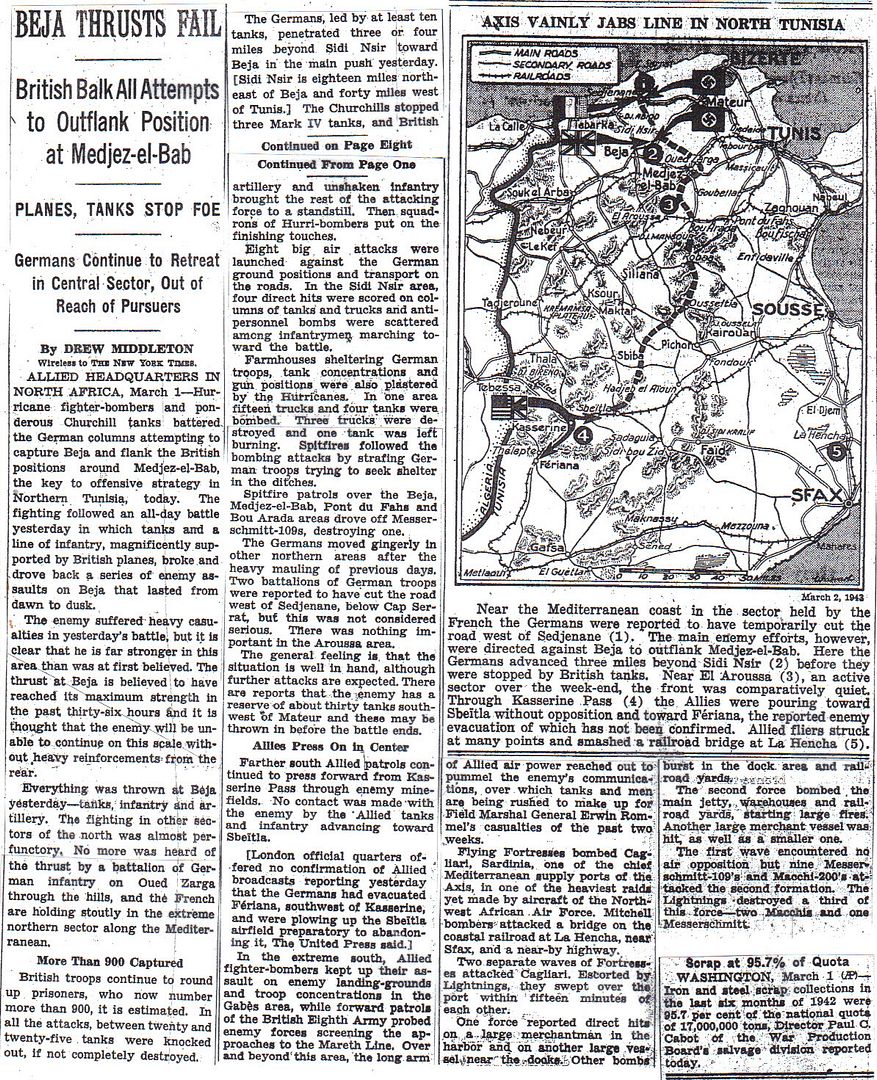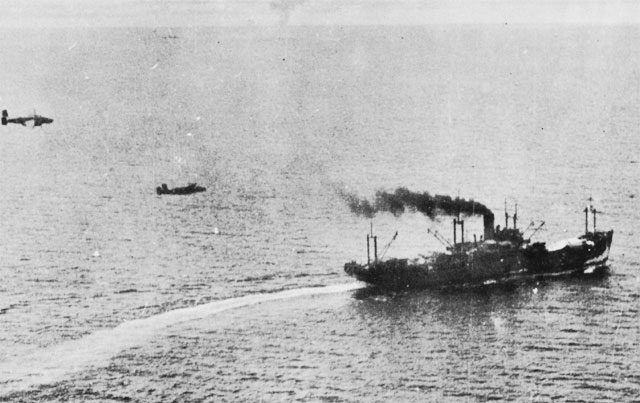
Posted on 03/02/2013 5:32:11 AM PST by Homer_J_Simpson














I agree with the Deputy Prime Minister’s minute about the expenses of military funerals, and I think you should welcome the opportunity of placing all military funerals, whether of soldiers or of officers, on a satisfactory dignified and honourable basis.
Pray let me have amended proposals more in harmony with the spirit of the times. I will assist you with the Treasury.
Winston S. Churchill, The Hinge of Fate
Air Drive Keeps Up – 2
Timoshenko Victor – 3
Beja Thrusts Fail (Middleton) – 4
Anglo-U.S. Strain in Tunisia Noted (Kluckhohn) – 5
War News Summarized – 5
14 Japanese Vessels Sighted Heading Toward New Guinea (Durdin) – 6
Save Doomed Jews, Huge Rally Pleads – 7-8
Proposals for Aiding Jews – 7
Poland is Accused of Imperialist Aim – 9
Tunisia Rehearsal Held in California – 9
Nazis Disclose How the Sydney was Destroyed West of Australia – 10
The Texts of the Day’s Communiques on Fighting in Various Zones – 12-14
A Step in Preparing V-Mail for Our Men Overseas – 14
http://www.onwar.com/chrono/1943/mar1943/f02mar43.htm
Allied planes hit Japanese convoy
Tuesday, March 2, 1943 www.onwar.com
B-24 bombers from 5th Air Force In the Bismark Sea [Photo at link]
A Japanese convoy of 8 ships, carrying the 7000 troops of the 51st Division (General Nakano), escorted by 8 destroyers, is sighted by Allied forces. Planes from the 5th Air Force (General Kenney) attack the convoy. The Japanese are heading for Lae from Rabaul.
In Tunisia... US forces recover Sbeitla and advance toward Feriana. To their north, the British hold against Axis attacks.
In Burma... The southern Chindit group experiences a setback in meeting its immediate objectives.
http://homepage.ntlworld.com/andrew.etherington/frame.htm
March 2nd, 1943 (TUESDAY)
UNITED KINGDOM: Frigate HMS Deveron commissioned.
ASW trawler HMS Bream commissioned. (Dave Shirlaw)
GERMANY: Berlin: In the heaviest raid so far of the war against Berlin, RAF heavy bombers dropped 8,000-pound high-explosive bombs and thousands of incendiaries in an attack last night on the city centre. Much damage is concentrated around the Unter den Linden, the Opera and cathedral of St Hedwig. One pilot said later: “It was a fearsome sight, but no regrets ... remember what the Nazis did to London.” The Germans later said that 191 people were killed and 268 injured. A total of 17 aircraft did not come back. Berlin threatens reprisal raids against New York and Washington, without suggesting how these might be achieved.
U-1167, U-1229 laid down.
U-859 launched. (Dave Shirlaw)
ITALY: Rome: Mussolini withdraws his troops from the eastern front.
PACIFIC OCEAN: The Battle of the Bismark Sea begins. A Japanese convoy of 8 transports enroute from Rabaul to Lae, New Guinea, and escorted by 8 destroyers is sighted and attacks begin. These attacks will continue through March 4. 3,500 soldiers of the 51st Division are lost. This is the last major troop movement to a combat zone by surface ships by the Japanese where they do not have control of the air.
U.S.A.: Destroyer USS Fullam commissioned.
Destroyer USS Dortch laid down. (Dave Shirlaw)
ATLANTIC OCEAN: At 0643, U-634 fired a spread of four torpedoes at SS Meriwether Lewis, a straggler from Convoy HX-227, and hit her with one torpedo after eight minutes. The ship sank bow first following two coups de grâce at 0752 and 0905after a heavy detonation in the forward part of the ship when the cargo of ammunition blew up. Earlier the ship had been attacked and missed by U-759, which then had troubles with the diesel engines and led the other U-boat to her target. USCGC Ingham searched the area for two days and only located a trail of automobile tires that stretched for 30 miles. All eight officers, 36 crewmen and 25 armed guards (the ship was armed with one 4in, one 3in and eight 20mm guns) were lost.
HMCS Assiniboine, a River-class destroyer leader, (ex-HMS Kempenfelf) Cdr. Kenneth Frederick Adams, RCN, CO, was damaged during an attack on U-119, Kptlt. Alois ZECH, CO, from the detonation of her own depth charges, which had inadvertently been set too shallow. The submarine avoided the attack and there was no further contact. Assiniboine had recently returned to service in December 41 as a member of Escort Group C-3, after a refit to repair damage done when she rammed and sank U-210, on 06 Aug 42. She made one round-trip, escorting convoys HX-221 (36 ships, none lost) and ONS-163 (38 ships, none lost) during the last of which she also suffered damage (cause unknown). She was on passage back to the UK to rejoin the C-3 group, which was preparing to take convoy ON-172 back to North America, when she was damaged again. She encountered U-119 on the surface by chance 660 miles west of Ireland as the U-boat was returning after laying a minefield off Iceland. Assiniboine closed to attack and opened fire when in gun range. The U-boat dove and Assiniboine attempted to ram, but only struck a glancing blow. Despite the fact that U-119 had lost three meters of her bow casing and her conning tower had been holed by 20-mm Oerlikon rounds, she remained at sea and refuelled ten attack U-boats north of the Azores before proceeding to Bordeaux for repairs. Assiniboine, having had plating in both boiler rooms pushed in and with one of her two screws out of action, proceeded to Liverpool for repairs which took 16 weeks. In the 22 months between Oct 41 and Jul 43, the critical period in the Battle of the Atlantic, Assiniboine was out of action for damage repair for a total of 12 months. (Dave Shirlaw)
Noted the p6 article where Japanese General Soto complains that the Americans aren’t fighting fairly. I can’t remember who it was but another Japanese general spoke out in late 1942 about Americans using “gangster tactics” in the New Guinea and Solomon Sea area by virtue of skip bombing, para-fragging and employing field designed strafing variants of the A-20 and B-25.

The Battle of the Bismarck Sea is one of the most decisive victories in military history.

Looks like the deck guns have been silenced. Note the lack of return fire and barrels not pointing towards the airplanes. Crewmen are laying dead, wounded or standing under whatever shelter they can get. Next pass will probably be skipbombing
I assumed the bulk of the damage done to Japanese ships was by dive bombers and torpedo bombers and that traditional horizontal bombing was of little use against ships. Now I realize the innovative thinking helped turn the medium and heavy bombers into instruments of destruction against the IJN. I read about the skip-bombing (and will post an excerpt of same tomorrow) but it didn’t sink in until now. I wonder what I forgot in order to make room for this new knowledge.
Here's some footage of the battle, taken by an RAAF Beaufighter. They get the stats wrong at the start of the film, but this was quite often the case throughout the war, on both sides.
While searching for the B-25, the team finds the wreckage of a P-47 Thunderbolt and the remains of its pilot. Using a satellite uplink, they are able to confirm that the pilot is listed as MIA and also track down one of his sisters. The businessman then calls her over a satellite phone (with the documentary film crew recording everything) to tell her the news. What he'd forgotten was that it was Thanksgiving back in the US, so he was able to give the good news to the entire family.
After hanging up with them, he contacted CILHI and they were able to send a team out to recover the remains and give his family some closure.
New Guinea has some really high mountains and quite a few aircraft were lost in a manner similar to that of the one you describe.
I imagine the general scenario was battle damage or mechanical trouble would force the plane to a lower altitude. Once at lower altitude, bad weather and a slight navigation error was all it took to miss a gap between 15K foot mountains.
Just a few miles from the airfield is the Zachary Taylor National Cemetery. At the front of the cemetery are over one hundred mass graves from all of the transports that were lost due to training accidents. If you have two hundred hours of flight time and something goes wrong with your plane, you might be able to recover; but if you have ten hours of flight time and something happens, you'd best kiss your tail goodbye.
Disclaimer: Opinions posted on Free Republic are those of the individual posters and do not necessarily represent the opinion of Free Republic or its management. All materials posted herein are protected by copyright law and the exemption for fair use of copyrighted works.